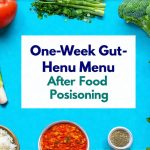Indigestion is an incredibly common experience, something most people will encounter at least occasionally throughout their lives. It’s often dismissed as simply ‘having a sensitive stomach’, but the root causes can be surprisingly diverse. While stress, dietary choices, and underlying conditions frequently play a role, one less-discussed trigger for indigestion – and potentially more serious illness – is the consumption of undercooked foods. This isn’t necessarily about dramatic food poisoning events, though those are certainly relevant; it’s also about the subtle discomfort, bloating, nausea, and digestive upset that can arise from inadequate cooking, particularly when dealing with meats, poultry, seafood, and eggs. Understanding how to recognize indigestion stemming from improperly prepared food is crucial for protecting your health and making informed choices in the kitchen.
The issue isn’t always obvious. We often associate foodborne illness with immediate, violent symptoms. However, mild reactions to undercooked food can mimic other digestive issues, leading people to overlook the true source of their discomfort. This can be particularly problematic because even seemingly minor exposure to harmful bacteria or parasites can have cumulative effects on health over time. Recognizing the specific warning signs related to inadequate cooking allows for quicker identification and preventative measures, helping you minimize risk and ensure your meals are safe as well as enjoyable. It’s about being a proactive participant in your own wellbeing, not just reacting when symptoms become severe.
Identifying the Source: Indigestion vs. Foodborne Illness
Distinguishing between general indigestion and indigestion caused by undercooked food can be tricky. Typical indigestion often presents as heartburn, bloating, gas, nausea, or a feeling of fullness even after eating only a small amount. These symptoms are frequently linked to dietary factors like spicy foods, caffeine, alcohol, or simply overeating. However, when the discomfort appears specifically after consuming certain foods – particularly meat, poultry, seafood, or eggs – and is accompanied by additional signs, it warrants closer attention. The timing of symptom onset is a key indicator. While general indigestion might develop gradually, symptoms from undercooked food often appear within hours, sometimes even minutes, after eating.
A significant difference lies in the nature of the digestive upset. Indigestion due to dietary choices typically improves relatively quickly with over-the-counter remedies or by adjusting your diet. Indigestion linked to insufficiently cooked foods is more likely to be accompanied by: – Mild stomach cramps – A feeling of nausea that persists – not just a fleeting sensation – Diarrhea, even if mild – General malaise or fatigue. These symptoms suggest the body is actively working to eliminate something harmful, rather than simply reacting to food sensitivities.
It’s also important to consider the type of food consumed. Raw or undercooked seafood carries a higher risk of parasitic infection and can lead to more prolonged digestive issues. Poultry is frequently associated with Salmonella, while beef can harbor E. coli if not cooked thoroughly. Recognizing these associations can help you pinpoint potential sources when experiencing digestive problems after a meal. Don’t dismiss persistent symptoms as ‘just indigestion’; investigate the possibility of food-related causes. If you frequently experience discomfort, it could be related to constipation patterns and underlying anxieties.
Understanding Temperature Danger Zones & Safe Cooking Practices
The “danger zone” in food safety refers to the temperature range between 40°F (4°C) and 140°F (60°C). Within this range, bacteria multiply rapidly, increasing the risk of illness. Foods left within this temperature for more than two hours – or one hour if the ambient temperature is above 90°F (32°C) – become unsafe to eat. This applies not only during storage but also during cooking; food must reach a safe internal temperature to kill harmful microorganisms. It’s crucial to remember that appearance isn’t always an indicator of safety—a browned exterior doesn’t guarantee the interior is thoroughly cooked.
Safe cooking practices are paramount. – Always use a food thermometer to verify internal temperatures. – For poultry, the minimum safe internal temperature is 165°F (74°C). – Beef, pork, lamb and veal steaks, roasts and chops should be cooked to at least 145°F (63°C) and allowed to rest for three minutes before serving. – Seafood should reach 145°F (63°C) or until it is opaque and flakes easily with a fork. – Eggs should be cooked until both the yolk and white are firm.
Proper handling before cooking also plays a vital role. This includes washing hands thoroughly, preventing cross-contamination between raw and cooked foods, and thawing frozen meats properly (ideally in the refrigerator, not at room temperature). Investing in a reliable food thermometer is one of the most effective steps you can take to ensure food safety. It might even help prevent bathroom rhythm loss associated with dietary changes.
Recognizing Symptoms Related To Specific Foods
Different types of undercooked food carry different risks and therefore present with slightly varying symptoms. Undercooked poultry is often linked to Salmonella, which typically causes diarrhea, fever, abdominal cramps, and vomiting within 12-72 hours after infection. Undercooked beef can harbor E. coli O157:H7, a particularly dangerous strain that can lead to severe stomach cramps, bloody diarrhea, and even kidney failure (hemolytic uremic syndrome). Symptoms usually appear 3-4 days after exposure.
Seafood poses unique challenges. Raw or undercooked fish may contain parasites like Anisakis, causing abdominal pain, nausea, vomiting, and diarrhea. Shellfish can accumulate toxins from contaminated waters, leading to paralytic shellfish poisoning (PSP) which causes numbness, tingling, muscle weakness, and difficulty breathing – a potentially life-threatening condition. It’s important to note that PSP symptoms require immediate medical attention. Undercooked eggs are often associated with Salmonella as well, presenting similar symptoms to those caused by contaminated poultry.
The severity of symptoms can vary greatly depending on the individual’s immune system and the amount of contaminant ingested. Infants, young children, pregnant women, and people with weakened immune systems are particularly vulnerable to foodborne illnesses. If you suspect you’ve consumed undercooked food and are experiencing significant or prolonged symptoms, seeking medical advice is essential. Sometimes these issues can be related to liver problems, so it’s important to rule those out.
What To Do If You Suspect Undercooked Food Indigestion
If you believe your indigestion stems from eating undercooked food, the first step is to stay hydrated. Drinking plenty of fluids helps flush out toxins and prevent dehydration caused by diarrhea or vomiting. Avoid solid foods for a few hours to give your digestive system a rest. When you do start eating again, choose bland, easily digestible options like toast, rice, bananas, and applesauce (the BRAT diet). Avoid fatty, spicy, or heavily seasoned foods.
Over-the-counter anti-diarrheal medications can provide temporary relief, but should be used cautiously and only if diarrhea is mild. If your symptoms are severe – including high fever, bloody stools, persistent vomiting, dehydration, or neurological symptoms like numbness or difficulty breathing – seek immediate medical attention. It’s also wise to inform anyone who may have consumed the same food.
Finally, take steps to prevent recurrence. Thoroughly clean and disinfect any surfaces that came into contact with raw meat, poultry, seafood, or eggs. Review your cooking practices and ensure you are using a food thermometer correctly. Proactive prevention is always better than reactive treatment. Remember, food safety isn’t just about avoiding illness; it’s about protecting your overall health and wellbeing. This type of discomfort can sometimes be linked to loose bowel days as well, so consider the emotional component. Understanding the source is critical, whether it’s a physical reaction or potentially related to fluctuating stress cycles. And if you struggle with dietary control, constipation caused by fear might be a factor to consider as well.


















